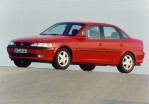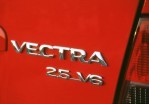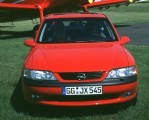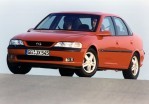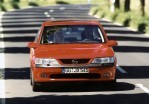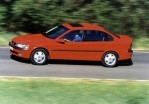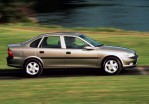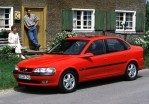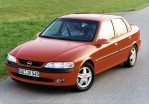Segment: Medium
Production years: 1995, 1996, 1997, 1998, 1999
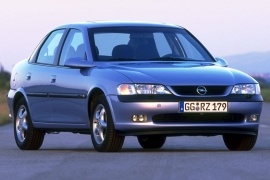 13 Photos
13 PhotosOpel introduced the second generation of the Vectra in 1995 at the Frankfurt Motor Show. It was one of the most important premieres from that year.
GM placed its bets on the Vectra. After a not very successful first generation, the design department burned the midnight oil to came up with a better-shaped vehicle, and the result was the 1995 Vectra, also known as Vectra B. It was a world car since it was sold under different names and badges. GM used the same platform for the Saturn L-Series, which was not that successful.
The 1995 Vectra was a significant improvement over its predecessor with more rounded areas and fluid shapes. It looked like GM partly agreed with the biodesign trend. A particular form was for the door-mirrors connected to the bodywork via an aerodynamic pillar that followed the hood's V-shaped lines. Its curved lines were extended over the greenhouse and formed an arched shape ended with a third window behind the rear doors.
Inside, the bucket-seats at the front were mounted low on the floor to create the impression of a sporty family sedan. The concept worked well for the front passengers but left little legroom for the rear ones. GM installed a refreshed dashboard with curved lines that looked appealing to its customers. Depending on the trim level, the instrument cluster featured an additional LCD for the on-board computer installed next to the dials.
Under the hood, Opel offered the Vectra B with a choice of five gasoline and a turbodiesel engine. Later on, in 1997, it introduced a new generation of direct-injected diesel versions fitted with four valves per cylinder. The carmaker paired all of them to a five-speed manual gearbox. For selected versions, the Vectra was available with a four-speed automatic transmission.
OPEL Vectra Sedan 1995, 1996, 1997, 1998, 1999
- 1.6i 16V 5MT FWD (100 HP
- 1.6i 5MT FWD (75 HP)
- 1.8i 16V 5MT FWD (115 HP)
- 2.0i 16V 5MT FWD (135 HP)
- 2.5i V6 5MT FWD (170 HP)
- 1.7L TD 5MT FWD (82 HP)
- 2.0L Di 5MT FWD (82 HP)
- 2.0L DTi 5MT FWD (100 HP)
OPEL Vectra Sedan
1.6i 16V 5MT FWD (100 HP
ENGINE SPECS - 1.6i 16V 5MT FWD (100 HP | |
|---|---|
| Cylinders: | L4 |
| Displacement: | 1598 cm3 |
| Power: | 74 KW @ 6200 RPM 100 HP @ 6200 RPM 99 BHP @ 6200 RPM |
| Torque: | 111 lb-ft @ 3200 RPM 150 Nm @ 3200 RPM |
| Fuel System: | Multipoint Injection |
| Fuel: | Gasoline |
PERFORMANCE SPECS | |
|---|---|
| Top Speed: | 116.8 mph (188 km/h) |
| Acceleration 0-62 Mph (0-100 kph): | 12.5 s |
TRANSMISSION SPECS | |
|---|---|
| Drive Type: | Front Wheel Drive |
| Gearbox: | 5-Speed manual |
BRAKES SPECS | |
|---|---|
| Front: | Ventilated Discs |
| Rear: | Discs |
TIRES SPECS | |
|---|---|
| Tire Size: | 185/70 HR14 |
DIMENSIONS | |
|---|---|
| Length: | 176.4 in (4481 mm) |
| Width: | 67.3 in (1709 mm) |
| Height: | 56.3 in (1430 mm) |
| Front/rear Track: | 58.3/57.9 in (1,481/1,471 mm) |
| Wheelbase: | 103.9 in (2639 mm) |
| Ground Clearance: | 5.5 in (140 mm) |
| Cargo Volume: | 17.7 cuFT (501 L) |
WEIGHT SPECS | |
|---|---|
| Unladen Weight: | 2579.4 lbs (1170 kg) |
| Gross Weight Limit: | 3814 lbs (1730 kg) |
FUEL ECONOMY (NEDC) | |
|---|---|
| City: | 20.8 mpg US (11.3 L/100Km) |
| Highway: | 38.5 mpg US (6.1 L/100Km) |
| Combined: | 29.4 mpg US (8 L/100Km) |
| CO2 Emissions: | 190.4 g/km |
OPEL Vectra Sedan
1.6i 5MT FWD (75 HP)
ENGINE SPECS - 1.6i 5MT FWD (75 HP) | |
|---|---|
| Cylinders: | L4 |
| Displacement: | 1598 cm3 |
| Power: | 55 KW @ 5200 RPM 75 HP @ 5200 RPM 74 BHP @ 5200 RPM |
| Torque: | 94 lb-ft @ 2600 RPM 128 Nm @ 2600 RPM |
| Fuel System: | Monopoint Injection |
| Fuel: | Gasoline |
PERFORMANCE SPECS | |
|---|---|
| Top Speed: | 108.7 mph (175 km/h) |
| Acceleration 0-62 Mph (0-100 kph): | 15.5 s |
TRANSMISSION SPECS | |
|---|---|
| Drive Type: | Front Wheel Drive |
| Gearbox: | 5-Speed manual |
BRAKES SPECS | |
|---|---|
| Front: | Ventilated Discs |
| Rear: | Drums |
TIRES SPECS | |
|---|---|
| Tire Size: | 175/70 TR14 |
DIMENSIONS | |
|---|---|
| Length: | 176.4 in (4481 mm) |
| Width: | 67.3 in (1709 mm) |
| Height: | 56.3 in (1430 mm) |
| Front/rear Track: | 58.3/57.9 in (1,481/1,471 mm) |
| Wheelbase: | 103.9 in (2639 mm) |
| Ground Clearance: | 5.5 in (140 mm) |
| Cargo Volume: | 17.7 cuFT (501 L) |
WEIGHT SPECS | |
|---|---|
| Unladen Weight: | 2506.7 lbs (1137 kg) |
| Gross Weight Limit: | 3747.9 lbs (1700 kg) |
FUEL ECONOMY (NEDC) | |
|---|---|
| City: | 22.4 mpg US (10.5 L/100Km) |
| Highway: | 39.9 mpg US (5.9 L/100Km) |
| Combined: | 30.9 mpg US (7.6 L/100Km) |
| CO2 Emissions: | 180.9 g/km |
OPEL Vectra Sedan
1.8i 16V 5MT FWD (115 HP)
ENGINE SPECS - 1.8i 16V 5MT FWD (115 HP) | |
|---|---|
| Cylinders: | L4 |
| Displacement: | 1799 cm3 |
| Power: | 85 KW @ 5400 RPM 115 HP @ 5400 RPM 114 BHP @ 5400 RPM |
| Torque: | 125 lb-ft @ 3600 RPM 170 Nm @ 3600 RPM |
| Fuel System: | Multipoint Injection |
| Fuel: | Gasoline |
PERFORMANCE SPECS | |
|---|---|
| Top Speed: | 116.8 mph (188 km/h) |
| Acceleration 0-62 Mph (0-100 kph): | 11 s |
TRANSMISSION SPECS | |
|---|---|
| Drive Type: | Front Wheel Drive |
| Gearbox: | 5-Speed manual |
BRAKES SPECS | |
|---|---|
| Front: | Ventilated Discs |
| Rear: | Discs |
TIRES SPECS | |
|---|---|
| Tire Size: | 185/70 HR14 |
DIMENSIONS | |
|---|---|
| Length: | 176.4 in (4481 mm) |
| Width: | 67.3 in (1709 mm) |
| Height: | 56.3 in (1430 mm) |
| Front/rear Track: | 58.3/57.9 in (1,481/1,471 mm) |
| Wheelbase: | 103.9 in (2639 mm) |
| Ground Clearance: | 5.5 in (140 mm) |
| Cargo Volume: | 17.7 cuFT (501 L) |
WEIGHT SPECS | |
|---|---|
| Unladen Weight: | 2672 lbs (1212 kg) |
| Gross Weight Limit: | 3913.2 lbs (1775 kg) |
FUEL ECONOMY (NEDC) | |
|---|---|
| City: | 19.8 mpg US (11.9 L/100Km) |
| Highway: | 36.7 mpg US (6.4 L/100Km) |
| Combined: | 28 mpg US (8.4 L/100Km) |
| CO2 Emissions: | 216.6 g/km |
OPEL Vectra Sedan
2.0i 16V 5MT FWD (135 HP)
ENGINE SPECS - 2.0i 16V 5MT FWD (135 HP) | |
|---|---|
| Cylinders: | L4 |
| Displacement: | 1998 cm3 |
| Power: | 100 KW @ 5600 RPM 135 HP @ 5600 RPM 134 BHP @ 5600 RPM |
| Torque: | 139 lb-ft @ 3200 RPM 188 Nm @ 3200 RPM |
| Fuel System: | Multipoint Injection |
| Fuel: | Gasoline |
PERFORMANCE SPECS | |
|---|---|
| Top Speed: | 133.6 mph (215 km/h) |
| Acceleration 0-62 Mph (0-100 kph): | 10 s |
TRANSMISSION SPECS | |
|---|---|
| Drive Type: | Front Wheel Drive |
| Gearbox: | 5-Speed manual |
BRAKES SPECS | |
|---|---|
| Front: | Ventilated Discs |
| Rear: | Discs |
TIRES SPECS | |
|---|---|
| Tire Size: | 195/65 VR15 |
DIMENSIONS | |
|---|---|
| Length: | 176.4 in (4481 mm) |
| Width: | 67.3 in (1709 mm) |
| Height: | 56.3 in (1430 mm) |
| Front/rear Track: | 58.3/57.9 in (1,481/1,471 mm) |
| Wheelbase: | 103.9 in (2639 mm) |
| Ground Clearance: | 5.5 in (140 mm) |
| Cargo Volume: | 17.7 cuFT (501 L) |
WEIGHT SPECS | |
|---|---|
| Unladen Weight: | 2760.2 lbs (1252 kg) |
| Gross Weight Limit: | 3979.3 lbs (1805 kg) |
FUEL ECONOMY (NEDC) | |
|---|---|
| City: | 19.3 mpg US (12.2 L/100Km) |
| Highway: | 36.2 mpg US (6.5 L/100Km) |
| Combined: | 27.3 mpg US (8.6 L/100Km) |
| CO2 Emissions: | 204.7 g/km |
OPEL Vectra Sedan
2.5i V6 5MT FWD (170 HP)
ENGINE SPECS - 2.5i V6 5MT FWD (170 HP) | |
|---|---|
| Cylinders: | V6 |
| Displacement: | 2498 cm3 |
| Power: | 125 KW @ 5800 RPM 170 HP @ 5800 RPM 168 BHP @ 5800 RPM |
| Torque: | 170 lb-ft @ 3200 RPM 230 Nm @ 3200 RPM |
| Fuel System: | Multipoint Injection |
| Fuel: | Gasoline |
PERFORMANCE SPECS | |
|---|---|
| Top Speed: | 142.9 mph (230 km/h) |
| Acceleration 0-62 Mph (0-100 kph): | 8.5 s |
TRANSMISSION SPECS | |
|---|---|
| Drive Type: | Front Wheel Drive |
| Gearbox: | 5-Speed manual |
BRAKES SPECS | |
|---|---|
| Front: | Ventilated Discs |
| Rear: | Discs |
TIRES SPECS | |
|---|---|
| Tire Size: | 195/65 VR15 |
DIMENSIONS | |
|---|---|
| Length: | 176.4 in (4481 mm) |
| Width: | 67.3 in (1709 mm) |
| Height: | 56.3 in (1430 mm) |
| Front/rear Track: | 58.3/57.9 in (1,481/1,471 mm) |
| Wheelbase: | 103.9 in (2639 mm) |
| Ground Clearance: | 5.5 in (140 mm) |
| Cargo Volume: | 17.7 cuFT (501 L) |
WEIGHT SPECS | |
|---|---|
| Unladen Weight: | 2901.3 lbs (1316 kg) |
| Gross Weight Limit: | 4166.7 lbs (1890 kg) |
FUEL ECONOMY (NEDC) | |
|---|---|
| City: | 16.7 mpg US (14.1 L/100Km) |
| Highway: | 30.1 mpg US (7.8 L/100Km) |
| Combined: | 23.3 mpg US (10.1 L/100Km) |
| CO2 Emissions: | 240.4 g/km |
OPEL Vectra Sedan
1.7L TD 5MT FWD (82 HP)
ENGINE SPECS - 1.7L TD 5MT FWD (82 HP) | |
|---|---|
| Cylinders: | L4 |
| Displacement: | 1686 cm3 |
| Power: | 60 KW @ 4400 RPM 82 HP @ 4400 RPM 80 BHP @ 4400 RPM |
| Torque: | 124 lb-ft @ 2400 RPM 168 Nm @ 2400 RPM |
| Fuel System: | Indirect Injection |
| Fuel: | Diesel |
| Fuel capacity: | 15.9 gallons (60.2 L) |
PERFORMANCE SPECS | |
|---|---|
| Top Speed: | 108.7 mph (175 km/h) |
| Acceleration 0-62 Mph (0-100 kph): | 15.5 s |
TRANSMISSION SPECS | |
|---|---|
| Drive Type: | Front Wheel Drive |
| Gearbox: | 5-Speed manual |
BRAKES SPECS | |
|---|---|
| Front: | Ventilated Discs |
| Rear: | Drums |
TIRES SPECS | |
|---|---|
| Tire Size: | 175/70 TR14 |
DIMENSIONS | |
|---|---|
| Length: | 176.4 in (4481 mm) |
| Width: | 67.3 in (1709 mm) |
| Height: | 56.3 in (1430 mm) |
| Front/rear Track: | 58.3/57.9 in (1,481/1,471 mm) |
| Wheelbase: | 103.9 in (2639 mm) |
| Ground Clearance: | 5.5 in (140 mm) |
| Cargo Volume: | 17.7 cuFT (501 L) |
WEIGHT SPECS | |
|---|---|
| Unladen Weight: | 2738.1 lbs (1242 kg) |
| Gross Weight Limit: | 3946.3 lbs (1790 kg) |
FUEL ECONOMY (NEDC) | |
|---|---|
| City: | 29 mpg US (8.1 L/100Km) |
| Highway: | 44.4 mpg US (5.3 L/100Km) |
| Combined: | 37.3 mpg US (6.3 L/100Km) |
| CO2 Emissions: | 167.7 g/km |
OPEL Vectra Sedan
2.0L Di 5MT FWD (82 HP)
ENGINE SPECS - 2.0L Di 5MT FWD (82 HP) | |
|---|---|
| Cylinders: | L4 |
| Displacement: | 1994 cm3 |
| Power: | 60 KW @ 4300 RPM 82 HP @ 4300 RPM 80 BHP @ 4300 RPM |
| Torque: | 136 lb-ft @ 1800 RPM 185 Nm @ 1800 RPM |
| Fuel System: | Direct Injection |
| Fuel: | Diesel |
| Fuel capacity: | 15.9 gallons (60.2 L) |
PERFORMANCE SPECS | |
|---|---|
| Top Speed: | 110.6 mph (178 km/h) |
| Acceleration 0-62 Mph (0-100 kph): | 15.5 s |
TRANSMISSION SPECS | |
|---|---|
| Drive Type: | Front Wheel Drive |
| Gearbox: | 5-Speed manual |
BRAKES SPECS | |
|---|---|
| Front: | Ventilated Discs |
| Rear: | Drums |
TIRES SPECS | |
|---|---|
| Tire Size: | 175/70 TR14 |
DIMENSIONS | |
|---|---|
| Length: | 176.4 in (4481 mm) |
| Width: | 67.3 in (1709 mm) |
| Height: | 56.3 in (1430 mm) |
| Front/rear Track: | 58.3/57.9 in (1,481/1,471 mm) |
| Wheelbase: | 103.9 in (2639 mm) |
| Ground Clearance: | 5.5 in (140 mm) |
| Cargo Volume: | 17.7 cuFT (501 L) |
WEIGHT SPECS | |
|---|---|
| Unladen Weight: | 2837.3 lbs (1287 kg) |
| Gross Weight Limit: | 4012.4 lbs (1820 kg) |
FUEL ECONOMY (NEDC) | |
|---|---|
| City: | 29.8 mpg US (7.9 L/100Km) |
| Highway: | 49 mpg US (4.8 L/100Km) |
| Combined: | 39.9 mpg US (5.9 L/100Km) |
| CO2 Emissions: | 204.7 g/km |
OPEL Vectra Sedan
2.0L DTi 5MT FWD (100 HP)
ENGINE SPECS - 2.0L DTi 5MT FWD (100 HP) | |
|---|---|
| Cylinders: | L4 |
| Displacement: | 1994 cm3 |
| Power: | 74 KW @ 4300 RPM 101 HP @ 4300 RPM 99 BHP @ 4300 RPM |
| Torque: | 151 lb-ft @ 1600 RPM 205 Nm @ 1600 RPM |
| Fuel System: | Direct Injection |
| Fuel: | Diesel |
| Fuel capacity: | 15.9 gallons (60.2 L) |
PERFORMANCE SPECS | |
|---|---|
| Top Speed: | 121.2 mph (195 km/h) |
| Acceleration 0-62 Mph (0-100 kph): | 13 s |
TRANSMISSION SPECS | |
|---|---|
| Drive Type: | Front Wheel Drive |
| Gearbox: | 5-Speed manual |
BRAKES SPECS | |
|---|---|
| Front: | Ventilated Discs |
| Rear: | Discs |
TIRES SPECS | |
|---|---|
| Tire Size: | 185/70 HR14 |
DIMENSIONS | |
|---|---|
| Length: | 176.4 in (4481 mm) |
| Width: | 67.3 in (1709 mm) |
| Height: | 56.3 in (1430 mm) |
| Front/rear Track: | 58.3/57.9 in (1,481/1,471 mm) |
| Wheelbase: | 103.9 in (2639 mm) |
| Ground Clearance: | 5.5 in (140 mm) |
| Cargo Volume: | 17.7 cuFT (501 L) |
WEIGHT SPECS | |
|---|---|
| Unladen Weight: | 2837.3 lbs (1287 kg) |
| Gross Weight Limit: | 4012.4 lbs (1820 kg) |
FUEL ECONOMY (NEDC) | |
|---|---|
| City: | 29.4 mpg US (8 L/100Km) |
| Highway: | 50 mpg US (4.7 L/100Km) |
| Combined: | 39.9 mpg US (5.9 L/100Km) |
| CO2 Emissions: | 156.4 g/km |



